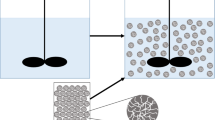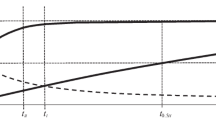Abstract
Modelling of liquid–solid batch adsorption based on mass transfer and conservation equations results in differential equations that may have or not an analytical solution. Even when analytical solutions are available, several simplified models can be considered for evaluating kinetic data of batch adsorption experiments. However, these simplified models are commonly used regardless of the premises considered in its development, and the analysis of the kinetic experiments based on these simplified models may be severely compromised. For this reason, this work presents a detailed development of the phenomenological models, and the hypotheses considered in its development are clearly stated. Typical simplified models derived from the phenomenological ones are obtained, and the conditions considered in the simplification are critically assessed. It was observed that the simplified models fail mainly for considering the concentration of the bulk phase constant over time or considering a linear adsorption isotherm. It must be emphasised that even when phenomenological models must be solved through numerical procedures, its use must be preferred, since the agreement with model premises and experimental conditions are closer, ensuring the quality of the kinetic data analysis.







Similar content being viewed by others
Data availability
The datasets used and analysed during the current study are available from the corresponding author on reasonable request.
References
Ahmad MA, Rahman NK (2011) Equilibrium, kinetics and thermodynamic of Remazol Brilliant Orange 3R dye adsorption on coffee husk-based activated carbon. Chem Eng J 170:154–161
Albadarin AB, Al-Muhtaseb AH, Al-laqtah NA et al (2011) Biosorption of toxic chromium from aqueous phase by lignin: mechanism, effect of other metal ions and salts. Chem Eng J 169:20–30. https://doi.org/10.1016/j.cej.2011.02.044
Alkan M, Demirbaş Ö, Doǧan M (2007) Adsorption kinetics and thermodynamics of an anionic dye onto sepiolite. Microporous Mesoporous Mater 101:388–396. https://doi.org/10.1016/j.micromeso.2006.12.007
Allen SJ, McKay G, Khader KYH (1989) Intraparticle diffusion of a basic dye during adsorption onto sphagnum peat. Environ Pollut 56:39–50. https://doi.org/10.1016/0269-7491(89)90120-6
Basu S, Ghosh G, Saha S (2018) Adsorption characteristics of phosphoric acid induced activation of bio-carbon: equilibrium, kinetics, thermodynamics and batch adsorber design. Process Saf Environ Prot 117:125–142. https://doi.org/10.1016/j.psep.2018.04.015
Boyd GE, Adamson AW, Myers LS (1947) The exchange adsorption of ions from aqueous solutions by organic zeolites. II. Kinetics. J Am Chem Soc 69:2836–2848. https://doi.org/10.1021/ja01203a066
Brandani S (2020) Kinetics of liquid phase batch adsorption experiments. Adsorption. https://doi.org/10.1007/s10450-020-00258-9
Chatterjee A, Schiewer S (2014) Multi-resistance kinetic models for biosorption of Cd by raw and immobilized citrus peels in batch and packed-bed columns. Chem Eng J 244:105–116
Chen Y, Zhang D (2014) Adsorption kinetics, isotherm and thermodynamics studies of flavones from Vaccinium Bracteatum Thunb leaves on NKA-2 resin. Chem Eng J 254:579–585. https://doi.org/10.1016/j.cej.2014.05.120
Chien SH, Clayton WR (1980) Application of Elovich equation to the kinetics of phosphate release and sorption in soils. Soil Sci Soc Am J 44:265–268
Coates JI, Glueckauf E (1947) Theory of chromatography. Part III. Experimental separation of two solutes and comparison with theory. J Chem Soc: 1308–1314. https://doi.org/10.1039/JR9470001308
Crank J (1975) The mathematics of diffusion, 2nd edn. Oxford University Press, Oxford
Da Ros S, Schwaab M, Pinto JC (2017) Parameter estimation and statistical methods. In: Reference Module in Chemistry, Molecular Sciences and Chemical Engineering. Elsevier Inc., pp 1–21. https://doi.org/10.1016/B978-0-12-409547-2.13918-6
de Assis Filho RB, Baptisttella AMS, de Araujo CMB et al (2021) Removal of textile dyes by benefited marine shells wastes: from circular economy to multi-phenomenological modeling. J Environ Manage 296:113222. https://doi.org/10.1016/j.jenvman.2021.113222
Digiano FA, Weber WJ (1973) Sorption experiments kinetics in infinite-bath experiments. J Water Pollut Control Fed 45:713–725
Do DD (1998) Adsorption analysis: equilibria and kinetics. Imperial College Press, London
Do DD, Rice RG (1987) On the relative importance of pore and surface diffusion in non-equilibrium adsorption rate processes. Chem Eng Sci 42:2269–2284
Do DD, Rice RG (1990) Applicability of the external-diffusion model in adsorption studies. Chem Eng Sci 45:1419–1421. https://doi.org/10.1016/0009-2509(90)87136-G
Dotto GL, Pinto LAA (2012) Analysis of mass transfer kinetics in the biosorption of synthetic dyes onto Spirulina platensis nanoparticles. Biochem Eng J 68:85–90. https://doi.org/10.1016/j.bej.2012.07.010
Edeskuty FJ, Amundson NR (1952) Effect of intraparticle diffusion: agitated nonflow adsorption systems. Ind Eng Chem 44:1698–1703
El-Khaiary MI, Malash GF (2011) Common data analysis errors in batch adsorption studies. Hydrometallurgy 105:314–320. https://doi.org/10.1016/j.hydromet.2010.11.005
Fallou H, Cimetière N, Giraudet S et al (2016) Adsorption of pharmaceuticals onto activated carbon fiber cloths - modeling and extrapolation of adsorption isotherms at very low concentrations. J Environ Manage 166:544–555. https://doi.org/10.1016/j.jenvman.2015.10.056
Furusawa T, Smith JM (1973) Fluid-particle and intraparticle mass transport rates in slurries. Ind Eng Chem Fundam 12:197–203. https://doi.org/10.1021/i160046a009
Glueckauf E (1955) Theory of chromatography part 10.-formula for diffusion into spheres and their application to chromatography. Trans Faraday Soc 51:1540–1551
Gupta VK, Suhas (2009) Application of low-cost adsorbents for dye removal - a review. J Environ Manage 90:2313–2342. https://doi.org/10.1016/j.jenvman.2008.11.017
Hills JH (1986) An investigation of the linear driving force approximation to diffusion in spherical particles. Chem Eng Sci 41:2779–2785. https://doi.org/10.1016/0009-2509(86)80009-4
Ho YS (2004) Citation review of Lagergren kinetic rate equation on adsorption reactions. Scientometrics 59:171–177
Ho YS, McKay G (1999) Pseudo-second order model for sorption processes. Process Biochem 34:451–465
Ho YS, McKay G (1998) The kinetics of sorption of basic dyes from aqueous solution by sphagnum moss peat. Can J Chem Eng 76:822–827. https://doi.org/10.1002/cjce.5450760419
Ho YS, Ng JCY, McKay G (2000) Kinetics of pollutant sorption by biosorbents: review. Sep Purif Methods 29:189–232. https://doi.org/10.1081/SPM-100100009
Inglezakis VJ, Fyrillas MM, Park J (2019) Variable diffusivity homogeneous surface diffusion model and analysis of merits and fallacies of simplified adsorption kinetics equations. J Hazard Mater 367:224–245. https://doi.org/10.1016/j.jhazmat.2018.12.023
Inglezakis VJ, Fyrillas MM, Stylianou MA (2018) Two-phase homogeneous diffusion model for the fixed bed sorption of heavy metals on natural zeolites. Microporous Mesoporous Mater 266:164–176. https://doi.org/10.1016/j.micromeso.2018.02.045
Koumanova B, Peeva P, Allen S (2003) Variation of intraparticle diffusion parameter during adsorption of p-chlorophenol onto activated carbon made from apricot stones. J Chem Technol Biotechnol 78:582–587. https://doi.org/10.1002/jctb.839
Largitte L, Pasquier R (2016) A review of the kinetics adsorption models and their application to the adsorption of lead by an activated carbon. Chem Eng Res Des 109:495–504. https://doi.org/10.1016/j.cherd.2016.02.006
Letterman RD, Quon JE, Gemmell RS (1974) Film transport coefficient in agitated suspensions of activated carbon. J Water Pollut Control Fed 46:2536–2546
Leyva-Ramos R, Geankoplis CJ (1994) Diffusion in liquid-filled pores of activated carbon. I. Pore volume diffusion. Can J Chem Eng 72:262–271. https://doi.org/10.1002/cjce.5450720213
Li Z, Yang RT (1999) Concentration profile for linear driving force model for diffusion in a particle. AIChE J 45:196–200. https://doi.org/10.1002/aic.690450118
Liaw CH, Wang JSP, Greenkorn RA, Chao KC (1979) Kinetics of fixed-bed adsorption: a new solution. AIChE J 25:376–381. https://doi.org/10.1002/aic.690250229
Lyn DA (1996) Asymptotic analysis of intraparticle diffusion in GAC batch reactors. J Environ Eng 122:1013–1021. https://doi.org/10.1061/(asce)0733-9372(1996)122:11(1013)
Malash GF, El-Khaiary MI (2010) Piecewise linear regression: a statistical method for the analysis of experimental adsorption data by the intraparticle-diffusion models. Chem Eng J 163:256–263. https://doi.org/10.1016/j.cej.2010.07.059
McKay G, Bino MJ, Altememi A (1986) External mass transfer during the adsorption of various pollutants onto activated carbon. Water Res 20:435–442. https://doi.org/10.1016/0043-1354(86)90190-9
McKay G, McConvey IF (1981) The external mass transfer of basic and acidic dyes on wood. J Chem Technol Biotechnol 31:401–408. https://doi.org/10.1002/jctb.503310155
Mercali GD, Fronza A, Marczak LDF (2021) Increase of mass transfer rates during osmotic dehydration of apples by application of moderate electric field. Int J Food Eng 17:199–208. https://doi.org/10.1515/ijfe-2020-0061
Ocampo-Pérez R, Leyva-Ramos R, Sanchez-Polo M, Rivera-Utrilla J (2013) Role of pore volume and surface diffusion in the adsorption of aromatic compounds on activated carbon. Adsorption 19:945–957. https://doi.org/10.1007/s10450-013-9502-y
Patton A, Crittenden BD, Perera SP (2004) Use of the linear driving force approximation to guide the design of monolithic adsorbents. Chem Eng Res Des 82:999–1009. https://doi.org/10.1205/0263876041580749
Perez EE, Carelli AA, Crapiste GH (2011) Temperature-dependent diffusion coefficient of oil from different sunflower seeds during extraction with hexane. J Food Eng 105:180–185. https://doi.org/10.1016/j.jfoodeng.2011.02.025
Qiu H, Lv L, Pan BC et al (2009) Critical review in adsorption kinetic models. J Zhejiang Univ Sci A 10:716–724. https://doi.org/10.1631/jzus.A0820524
Reichenberg D (1953) Properties of ion-exchange resins in relation to their structure. III. Kinetics of Exchange. J Am Chem Soc 75:589–597. https://doi.org/10.1021/ja01099a022
Rice RG (1982) Approximate solutions for batch, packed tube and radial flow adsorbers—comparison with experiment. Chem Eng Sci 37:83–91. https://doi.org/10.1016/0009-2509(82)80070-5
Rodrigues AE, Silva CM (2016) What’s wrong with Lagergreen pseudo first order model for adsorption kinetics? Chem Eng J 306:1138–1142. https://doi.org/10.1016/j.cej.2016.08.055
Roy D, te Wang G, Adrian DD (1993) A simplified solution technique for carbon adsorption model. Water Res 27:1033–1040. https://doi.org/10.1016/0043-1354(93)90067-R
Ruthven DM (1984) Principles of adsorption and adsorption processes. John Wiley & Sons, New Jersey
Schwaab M, Steffani E, Barbosa-Coutinho E, Severo Júnior JB (2017) Critical analysis of adsorption/diffusion modelling as a function of time square root. Chem Eng Sci 173:179–186. https://doi.org/10.1016/j.ces.2017.07.037
Silva MSP, Mota JPB, Rodrigues AE (2014) Adsorption equilibrium and kinetics of the Parex’ feed and desorbent streams from batch experiments. Chem Eng Technol 37:1541–1551. https://doi.org/10.1002/ceat.201300721
Simonin JP, Bouté J (2016) Intraparticle diffusion-adsorption model to describe liquid/solid adsorption kinetics. Rev Mex Ing Quím 15:161–173
Sircar S, Hufton JR (2000a) Intraparticle adsorbate concentration profile for linear driving force model. AIChE J 46:659–660. https://doi.org/10.1002/aic.690460325
Sircar S, Hufton JR (2000b) Why does the linear driving force model for adsorption kinetics work? Adsorption 6:137–147. https://doi.org/10.1023/A:1008965317983
Souza PR, Dotto GL, Salau NPG (2017) Detailed numerical solution of pore volume and surface diffusion model in adsorption systems. Chem Eng Res Des 122:298–307. https://doi.org/10.1016/j.cherd.2017.04.021
Souza PR, Dotto GL, Salau NPG (2020) Corrigendum to “Detailed numerical solution of pore volume and surface diffusion model in adsorption systems” [Chem Eng Res Des 122 (2017) 298–307]. Chem Eng Res Des 154:331–333. https://doi.org/10.1016/j.cherd.2019.10.006
Srivastava VC, Swamy MM, Mall ID et al (2006) Adsorptive removal of phenol by bagasse fly ash and activated carbon: equilibrium, kinetics and thermodynamics. Colloids Surf, A 272:89–104. https://doi.org/10.1016/j.colsurfa.2005.07.016
Tien C, Ramarao BV (2014) Further examination of the relationship between the Langmuir kinetics and the Lagergren and the second-order rate models of batch adsorption. Sep Purif Technol 136:303–308. https://doi.org/10.1016/j.seppur.2014.08.013
Turner NH (1975) Kinetics of chemisorption: an examination of the Elovich equation. J Catal 36:262–265. https://doi.org/10.1016/0021-9517(75)90035-4
Viegas RMC, Campinas M, Costa H, Rosa MJ (2014) How do the HSDM and Boyd’s model compare for estimating intraparticle diffusion coefficients in adsorption processes. Adsorption 20:737–746. https://doi.org/10.1007/s10450-014-9617-9
Vinhal JO, Lage MR, Carneiro JWM et al (2015) Modeling, kinetic, and equilibrium characterization of paraquat adsorption onto polyurethane foam using the ion-pairing technique. J Environ Manage 156:200–208. https://doi.org/10.1016/j.jenvman.2015.03.022
Weber WJ, Morris JC (1963) Kinetics of adsorption of carbon from solution. J Sanit Eng Div 3483:31–59
Yang RT (1997) Gas separation by adsorption processes. Imperial College Press, London
Yao C, Chen T (2017) A film-diffusion-based adsorption kinetic equation and its application. Chem Eng Res Des 119:87–92. https://doi.org/10.1016/j.cherd.2017.01.004
Yao C, Chen T (2015) A new simplified method for estimating film mass transfer and surface diffusion coefficients from batch adsorption kinetic data. Chem Eng J 265:93–99. https://doi.org/10.1016/j.cej.2014.12.005
Acknowledgements
The authors thank CNPq (Conselho Nacional de Desenvolvimento Científico e Tecnológico, Brazil) and CAPES (Coordenação de Aperfeiçoamento de Pessoal de Nível Superior, Brazil, Grant: 0001) (CAPES) for supporting this work and providing scholarships.
Author information
Authors and Affiliations
Contributions
VQ writing original draft; DSA writing and literature revision of LDF model; GHOM development and programming of finite bath models; ES revision of the manuscript; EBC revision of the manuscript; MS conceptualization and writing original draft.
Corresponding author
Ethics declarations
Ethics approval and consent to participate
Not applicable.
Consent for publication
Not applicable.
Competing interests
The authors declare no competing interests.
Additional information
Responsible Editor: Tito Roberto Cadaval Jr
Publisher's note
Springer Nature remains neutral with regard to jurisdictional claims in published maps and institutional affiliations.
Supplementary Information
Below is the link to the electronic supplementary material.
Rights and permissions
About this article
Cite this article
Queiroz, V., de Almeida, D.S., de Oliveira Miglioranza, G.H. et al. Analysis of commonly used batch adsorption kinetic models derived from mass transfer-based modelling. Environ Sci Pollut Res 29, 79875–79889 (2022). https://doi.org/10.1007/s11356-021-18479-y
Received:
Accepted:
Published:
Issue Date:
DOI: https://doi.org/10.1007/s11356-021-18479-y




